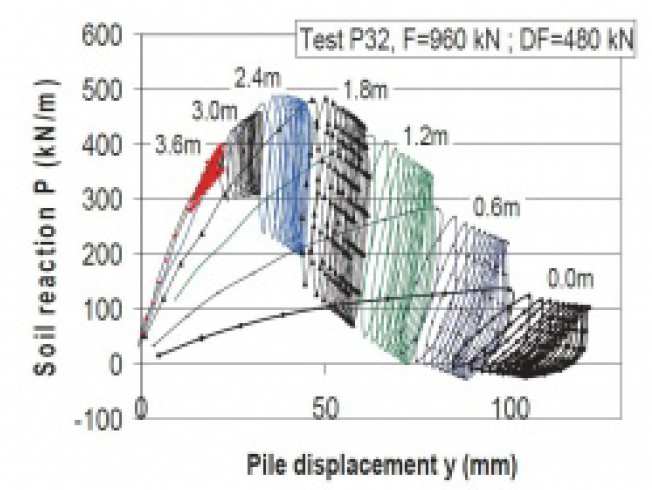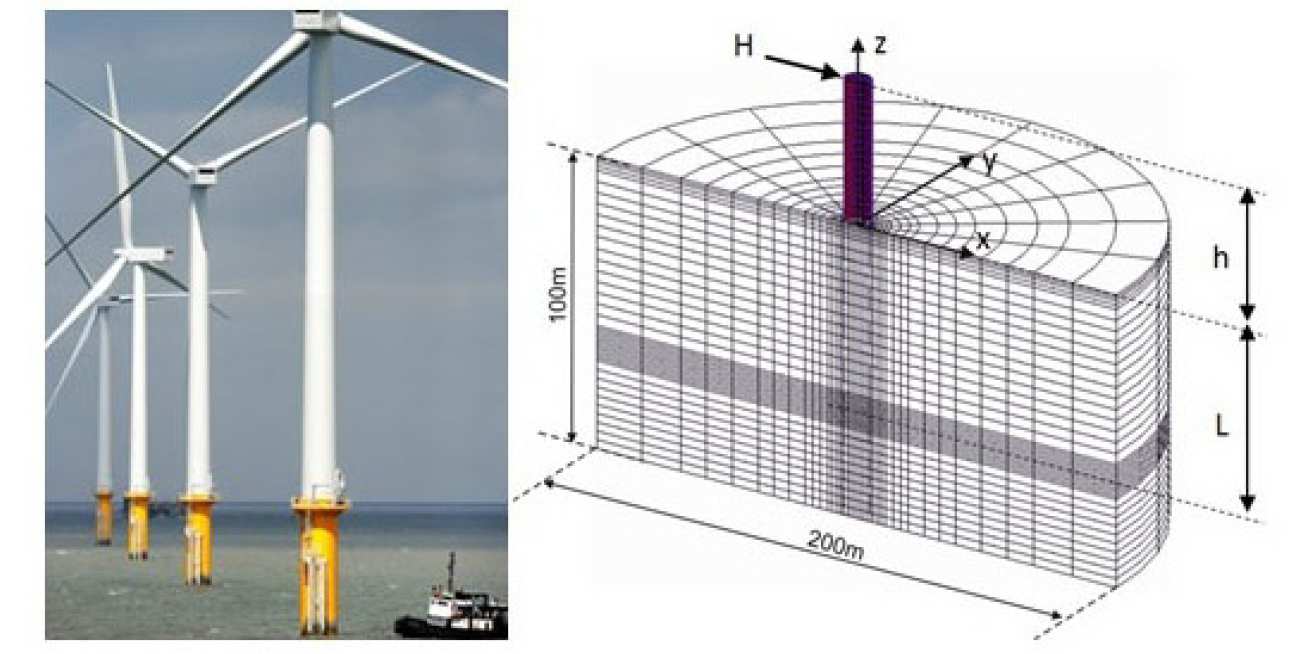David Abadias
Numerical analysis of monopiles for offshore wind turbines
Started: October 2014
Supervisor: Zdravkovic, L.; Taborda, D.
Funding: DONG Energy and partners
Description of Research
Design of monopiles for offshore wind turbine (OWT) application began in earnest some 15 years ago. It was soon realised that the available design methods had some serious shortcomings when applied to this task. The existing methodologies were developed for Oil & Gas type sub-structures, usually with different design criteria and loading conditions compared to the current OWT monopile sub-structures. Their inadequacy results primarily from the limitations of the experimental database for laterally loaded piles, in particular with respect to the number of cycles, range of cyclic loading, and dimensions and stiffness ratios of the monopiles tested. The long and slender piles for oil and gas structures, with length to diameter ratios (L/D) of over 30, have been replaced with short and rigid OWT piles with L/D in the range of 2 to 6 and a diameter of up to 10m envisaged for the next generation of turbines.

To improve the accuracy and efficiency of OWT monopile design, both research and practice have seen in recent years a surge of activities involving numerical analysis, model pile testing and large scale pile testing. One of the primary objectives has been to provide a better estimate of the stiffness and capacity of short and rigid monopiles under monotonic and cyclic loading. Most of the effort has been placed at improving the ‘p-y’ design methodology, examples of this being Rosquoeumlt (2004), Rosquoet et al (2007), Rakotonindriana (2009), Achmus, Abdel-Rahman & Kuo (2007), Achmus, Abdel-Rahman & Kuo (2007), Leblanc, Houlsby & Byrne (2010) or Cuellar et al (2014).
Soils under cyclic conditions show complex behaviour, requiring complex constitutive models to capture their real behaviour. An example of the motivation of the project is clear in the following figure, where one of the results obtained in the centrifuge facility of Nantes for a rigid monopile under cyclic loading conditions in sand is shown. It can clearly be seen that cyclic loading produces a significant reduction of the capacity and the stiffness with the number of cycles; affecting the main parameters of design.
Amongst all the efforts to improve design, the most ambitious recent project, initiated in 2013, has been the PISA (Pile Soil Analysis) project which involves large scale field tests of laterally loaded piles, numerical analysis and laboratory and field soil testing, integrated together to develop future design methodologies for OWT monopiles.
Research aims
The PISA project is a collaborative research effort involving Imperial College London (ICL), University of Oxford (UO) and University College Dublin (UCD) on the academic side, together with DONG Energy and nine offshore industry partners who are funding the project under the Carbon Trust’s Wind Accelerator Programme. The commercial activities of the project partners involve the design, construction and operation of several wind farms in Europe.
The ICL is responsible for numerical modelling of monopile foundations under the PISA project, utilising the bespoke finite element software ICFEP (Potts & Zdravkovic, 1999) developed in the Geotechnics research group. This work has already investigated the behaviour of monopiles under monotonic lateral loading in typical sand and clay soils equivalent to the North Sea ground conditions. Consequently, the focus of the current PhD project is on simulating the behaviour of monopiles under loading regimes involving a large number of cycles, representative of OWT working conditions. In particular, this project will investigate from a computational point of view how the accumulation of displacements and the degradation of the overall performance of the soil-structure system can be predicted with a greater degree of confidence than that offered by current design methods.

The identified patterns of behaviour will then lead to the formulation and implementation into ICFEP of an appropriate constitutive model capable of reproducing the evolution of pore pressures and development of strains during repeated loading. The developed tool will subsequently be validated by simulating both model and field tests, some of them executed during earlier stages of the PISA project. Lastly, the gathered information will be analysed in order to provide appropriate guidelines to the efficient and economical design of such structures.
References
- Achmus M, Abdelrahman K, Kuo YS. (2007) Numerical modelling of large diameter steel piles under monotonic and cyclic horizontal loading. 10th International Symposium on Numerical Models in Geomechanics. Rhodes, Greece, 2007: 453−459.
- Cuellar, P., Mira, P., Pastor, M., Fernandez Merodo, J. A., Baessler, M. & Ruecker, W. (2014). A numerical model for the transient analysis of offshore foundations under cyclic loading. Computers and Geotechnics, 59 75-86.
- Leblanc, C., Houlsby, G. T. & Byrne, B. W. (2010). Response of stiff piles in sand to long-term cyclic lateral loading. Geotechnique, 60 (2), 79-90.
- Potts D.M. and Zdravkovic L. (1999), Finite element analysis in geotechnical engineering: theory; Thomas Telford, London, UK.
- Rakotonindriana, J. (2009) Comportement des pieux et des groupes de pieux sous chargement latéral cyclique. Ecole nationale des ponts et chaussées.
- Rosquoët, F. (2004) Pieux sous charge latérale cyclique. PhD thesis. Nantes.
- Rosquoet, F., Thore, L., Garnier, J. & Canepa, Y. (2007). Lateral cyclic loading of sand-installed piles. Soils and Foundations, 47 (5), 821-832.
DAVID ABADIAS PhD Candidate - Geotechnics
PhD Candidate - Geotechnics
Department of Civil & Environmental Engineering
Imperial College London SW7 2AZ
d.abadias-gomez14@imperial.ac.uk


